The Commonwealth Fund 2006 Health Care Quality Survey presents new information about interventions that show promise for promoting equity in health care and addressing racial and ethnic disparities in access to high-quality care. Findings from this survey are promising, as they suggest that racial and ethnic disparities are not immutable. Indeed, disparities in terms of access to and quality of care largely disappear when adults have a medical home, insurance coverage, and access to high-quality services and systems of care. The survey finds that, when adults have a medical home, their access to care and rates of preventive screenings improve substantially. Practice systems, in the form of patient reminders, also improve the quality of care for vulnerable patients by promoting higher rates of routine preventive screening.
The Commonwealth Fund Health Care Quality Survey, conducted among adults from May to October 2006, highlights how stable insurance, having a regular provider and, in particular, a medical home, improves health care access and quality among vulnerable populations. Over the past 20 years, much work has been done to identify and develop a set of indicators that best captures the components of a medical home. In this report, a medical home is defined as a health care setting that provides patients with timely, well-organized care and enhanced access to providers. Survey respondents who have a medical home, report the following four features: they have a regular provider or place of care; they experience no difficulty contacting their provider by phone; they experience no difficulty getting care or advice on weekends or evenings; and they report that their office visits are always well organized and on schedule.
Following are some of the key findings of the survey.
Hispanics and African Americans are vulnerable: their uninsured rates are higher and they are less likely than whites to have access to a regular doctor or source of care.
- Among adults ages 18 to 64, nearly half of Hispanics (49%) and more than one of four African Americans (28%) were uninsured during 2006, compared with 21 percent of whites and 18 percent of Asian Americans (Figure ES-1).
- Hispanics and African Americans also have differential access to a regular doctor or source of care, with Hispanics particularly at risk. As many as 43 percent of Hispanics and 21 percent of African Americans report they have no regular doctor or source of care, compared with 15 percent of whites and 16 percent of Asian Americans.
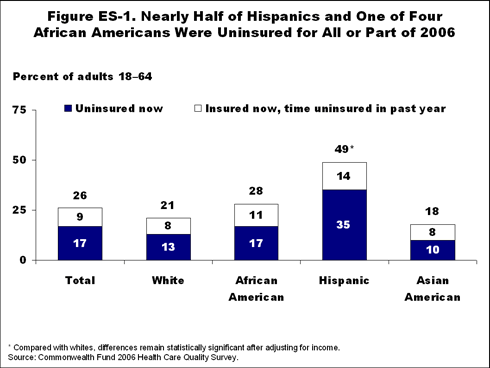
By definition, a medical home provides patients with enhanced access to providers and timely, organized care.
- Only 27 percent of adults ages 18 to 64 reported having all four indicators of a medical home: a regular doctor or source of care; no difficulty contacting their provider by telephone; no difficulty getting care or medical advice on weekends or evenings; and doctors visits that are well organized and running on time (Figure ES-2).
- Many providers do not offer medical care or advice during evenings or weekends. Only two-thirds of adults who have a regular provider or source of care say that it is easy to get care or advice after hours. Compared with other populations, Hispanics are least likely to have access to after-hours care.
- Among adults who have a regular doctor or source of care, African Americans are most likely to have a medical home that provides enhanced access to physicians and well-organized care. One-third of African Americans (34%) have a medical home, compared with 28 percent of whites, 26 percent of Asian Americans, and just 15 percent of Hispanics.
- The uninsured are the least likely to have a medical home. Only 16 percent of the uninsured receive care through a medical home; 45 percent do not have a regular source of care (Figure ES-3).
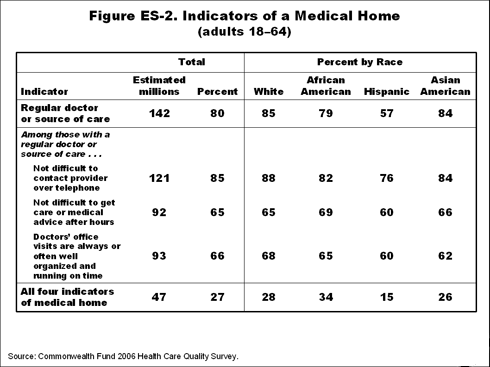
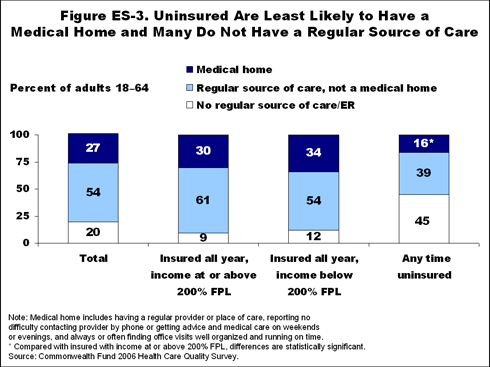
Medical homes reduce disparities in access to care.
- The vast majority (74%) of adults with a medical home always get the care they need, compared with only 52 percent of those with a regular provider that is not a medical home and 38 percent of adults without any regular source of care or provider.
- When minorities have a medical home, racial and ethnic differences in terms of access to medical care disappear. Three-fourths of whites, African Americans, and Hispanics with medical homes reported getting the care they need when they need it (Figure ES-4).
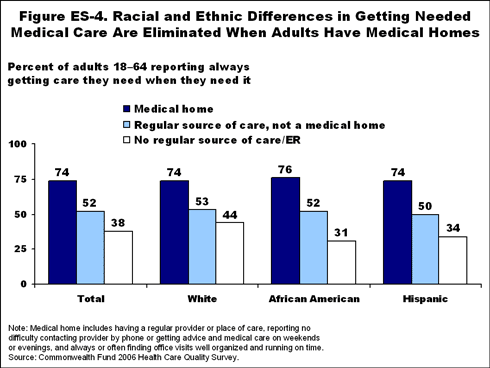
Use of reminders for preventive care is associated with higher rates of preventive screening. Among patients with medical homes, there are no racial disparities in terms of receipt of preventive care reminders.
- The use of reminders substantially increases the rates of routine preventive screenings, such as cholesterol screening, breast cancer screening, and prostate cancer screening. Eight of 10 (82%) adults who received a reminder had their cholesterol checked in the past five years, compared with half of adults who did not get a reminder.
- Men who received a reminder were screened for prostate cancer at twice the rate (70%) as those who did not get a reminder (37%).
- When minorities have a medical home, their access to preventive care improves substantially. Regardless of race or ethnicity, about two-thirds of all adults who have a medical home receive preventive care reminders (Figure ES-5).
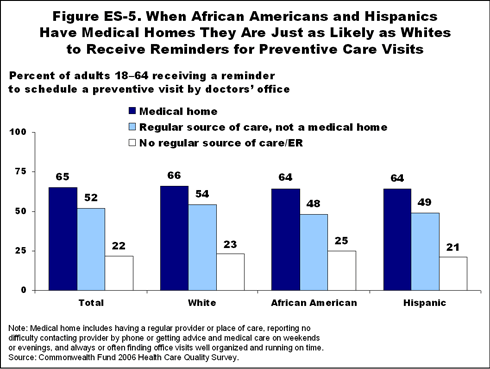
- More than half of insured adults (54%) received a reminder from a doctors' office to schedule a preventive visit, compared with only 36 percent of uninsured adults. When minority populations are insured, they are just as likely as white adults to receive reminders to schedule preventive care.
- Even among the uninsured, having a medical home affects whether patients receive preventive care reminders. Two-thirds of both insured and uninsured adults with medical homes receive preventive care reminders, compared with half of insured and uninsured adults without medical homes (Figure ES-6).
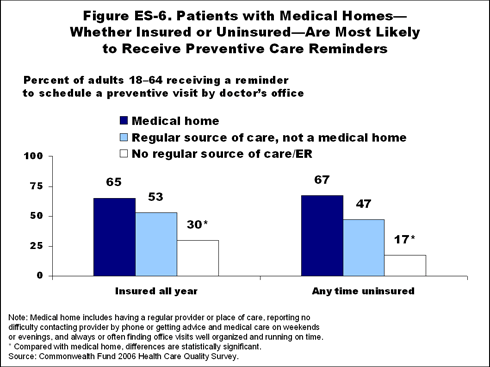
Adults with medical homes are better prepared to manage their chronic conditionsand have better health outcomesthan those who lack medical homes.
- The survey finds that adults who have medical homes are better prepared to manage their chronic conditions. Only 23 percent of adults with a medical home report their doctor or doctor's office did not give them a plan to manage their care at home, compared with 65 percent of adults who lack a regular source of care.
- Among hypertensive adults, 42 percent of those with a medical home reported that they regularly check their blood pressure and that it is well controlled. Only 25 percent of hypertensive adults with a regular source of care, but not a medical home, reported this (Figure ES-7).
- Adults with a medical home reported better coordination between their regular providers and specialists. Among those who saw a specialist, three-fourths said their regular doctor helped them decide whom to see and communicated with the specialist about their medical history, compared with 58 percent of adults without a medical home.
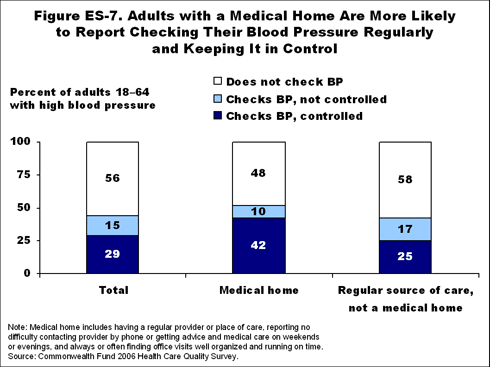
Community health centers and public clinicswhich care for many uninsured, low-income, and minority adultsare less likely than private doctors' offices to have features of a medical home.
- The survey finds that community health centers or public clinics serve 20 percent of the uninsured and 20 percent of low-income adults with coverage. In addition, 13 percent of African Americans and more than one of five Hispanics named community health centers or public clinics as their regular source of care.
- Patients who use community health centers or public clinics as their usual source of care are less likely than those who use private doctors' offices to have a medical home. Only 21 percent of adults using community health centers or public clinics reported that they have a regular doctor, have no difficulty contacting their provider by telephone or getting care or medical advice on weekends or evenings, and reported that their doctors' visits are always well organized and running on time. In contrast, 32 percent of patients who use private doctors' offices reported all features of a medical home. Difficulty getting medical advice or care in the evenings or on weekends is more pervasive in community health centers and public clinics than in private doctors' offices or clinics (Figure ES-8).
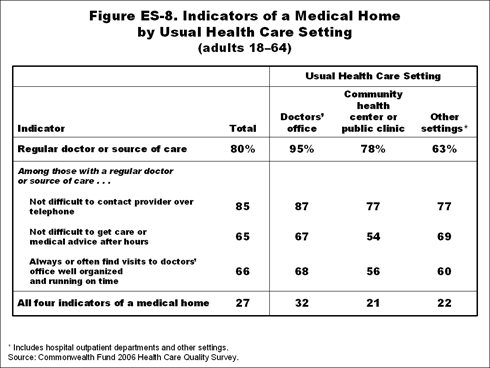
Conclusions
The Commonwealth Fund Health Care Quality Survey finds that, when patients have a medical home, racial and ethnic disparities in terms of access to and quality of care are reduced or eliminated. The survey results suggest that all providers should take steps to help create medical homes for patients. Community health centers and other public clinics, in particular, should be supported in their efforts to build medical homes, as they care for patients regardless of ability to pay. Improving the quality of health care delivered by safety net providers can have a significant impact on disparities by promoting equity and ensuring access to high-quality care.
In addition, the promotion of medical homes, including the establishment of standards, public reporting of performance, and rewards for achieving excellence, would support improvement in the delivery of health care services in all settings.